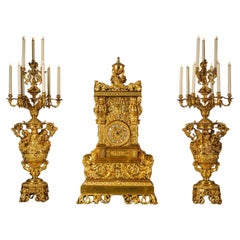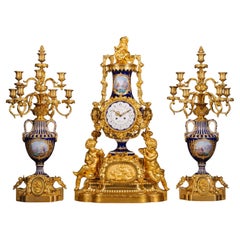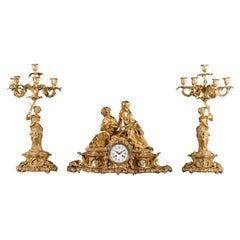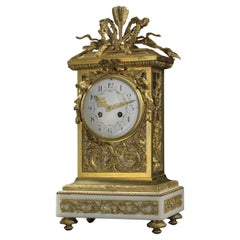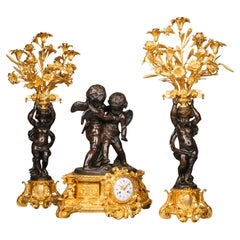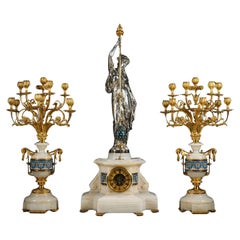Adrian Alan Mantel Clocks
to
32
32
13
2
1
1
32
21
12
12
12
32
32
32
Height
to
Width
to
32
32
32
2
2
2
2
1
A Monumental Renaissance Revival Clock Garniture, Attributed to Feuchère
Located in Brighton, West Sussex
A Large and Important Louis Philippe Period Gilt-Bronze Three-Piece Clock Garniture.
Attributed to the Feuchère family. The clock movement by Hémon.
In the Renaissance revival style. Comprising a clock and a pair of nine-light candelabra. The clock case of architectural out-shape with cherubic term figures supporting a rectangular pediment centred by an urn. The sides of the clock tower cast in relief with strapwork and foliage. The dial inset with enamel Roman numeral chapters. The twin-barrel clock movement with tic-tac escapement, silk suspension and countwheel strike to bell. Pendulum and winding key.
The candelabra as twin-handled vases supporting tiered branches with candle nozzles. Modelled en suite with naturalistic scrolls and foliage. Surmounted by finials modelled as an eagle toying with a serpent. The scrolled handles flanked by cherubic figures and serpents. The bodies fronted by bacchic masks and supported on socles bearing angels.
France, Circa 1835.
The clock movement signed ‘HEMON A PARIS’. The clockmaker Claude Hémon was established at rue de St. Martin circa 1810-1820.
Dimensions, the clock:
Height : 106 cm 42 inches
Width : 58 cm 23 inches
Depth : 38 cm 15 inches
Weight : 72 kg
Dimensions, the candelabra:
Height : 104 cm 41 inches
Width : 36 cm 14 inches
Depth : 36 cm 14 inches
Weight : 28 kg (each)
This magnificent clock garniture of palatial size is designed in the Renaissance revival style and dates to the Louis Philippe period. Executed in sculptural gilt-bronze with leaves, scrolls, masks and exotic birds, the naturalistic ornament represents an elaborate system of allegories and mythological iconography which recall the influence of Italian Mannerist art in France.
The distinctive design reflects a new style which replaced the neoclassism of the French Empire period. With the fall of Napoleon Bonaparte, artists and designers sought a new decorative vocabulary with which to aggrandise the Bourbon restoration. With the French revolution and Louis XVI’s execution still within living memory, it seemed too soon for a revival of the style of the Grand Siècle. Instead they looked further back to the time of François I, whose patronage of Italian artists had brought the Renaissance to France. The idea of a renaissance revival appealed to the new Bourbon monarchs and their patronage ignited great creativity in the arts.
The reigns of Louis XVIII and Charles X, who were brothers of the late King, Louis XVI, and later of Louis Philippe I, nicknamed the Citizen King, coincided with the enlightenment and the dawn of the industrial age. Great technical progress was made in metallurgy and casting which raised the art of bronze making to new heights in the hands of great masters such as Pierre-Philippe Thomire (1751-1843) and Pierre- Jean-François Denière (1774-1866).
The renaissance provided a rich and varied source book in architecture, furniture and other decorative arts for designers such as Claude Aimé Chenavard (1798-1838) whose Album de l’ornemaniste (1835) became a reference work. Léon Feuchère (1804-1857) also produced drawings of interiors, silver, bronzes and furniture and was a scion of the prominent family of bronze castors established by his grandfather Pierre-François Feuchère (1737-1823) who had worked as a gilder for the bronze caster Pierre Gouthière before setting up a bronze foundry that would become one of the largest in Paris under the management of his son Lucien-François (d. 1841) and grand-son Armand (1797-1866). A number of drawings by Léon Feuchère have recently been discovered by the Rijksmuseum and probably belonged to the collection of Louis-Philippe-Albert, duc d’Orléans, comte de Paris (1838-1894). Louis-Philippe-Albert was the grandson of the French king, Louis-Philippe I (1773-1850), who granted him the title of comte de Paris, and the son of Ferdinand-Philippe, duc d’Orléans (1810-1842). Ferdinand-Philippe was an important collector and sponsored many young artists to create metalwork objets d’art, notably a celebrated surtout de table made by Claude-Aimé Chenavard and Jean-Jacques Feuchère (1807-1852), a cousin of Armand and Léon. Principally remembered as a sculptor, Jean-Jacques Feuchère trained in the family foundry and designed small objects, cigar boxes...
Category
Antique Early 19th Century French Renaissance Revival Mantel Clocks
Materials
Bronze
A Napoleon III Period Sèvres Style Porcelain Three-Piece Clock Garniture
By Jean-François Denière
Located in Brighton, West Sussex
A Large and Exceptional Napoleon III Period Gilt-Bronze and Sèvres Style Porcelain Three-Piece Clock Garniture. By Denière, Paris.
Comprising a mantle clock and pair of eight-light...
Category
Antique 19th Century French Napoleon III Mantel Clocks
Materials
Enamel, Ormolu
A Fine Napoléon III Gilt-Bronze Three Piece Clock Garniture
Located in Brighton, West Sussex
A Fine Napoléon III Gilt-Bronze Three Piece Clock Garniture
Comprising a mantel clock and a pair of seven-light figural candelabra. Designed as a celebration of music and lyric poe...
Category
Antique 19th Century French Napoleon III Mantel Clocks
Materials
Enamel, Ormolu
A Louis XVI Style Mantel Fine Gilt-Bronze Clock by François Linke
By François Linke
Located in Brighton, West Sussex
A Very Fine Gilt-Bronze Clock With A White Marble Base by François Linke.
The case signed 'Linke'.
This rare example of a clock by François Linke has a twin train eight-day mov...
Category
Antique 19th Century French Louis XVI Mantel Clocks
Materials
Marble, Enamel, Ormolu
A Napoleon III Three Piece Figural Clock Garniture
By Charpentier et Cie
Located in Brighton, West Sussex
A Napoleon III Gilt and Patinated Bronze Three Pieces Figural Clock Garniture.
By Charpentier & Cie., Paris.
Comprising a mantle clock modelled with playful cherubs with white enam...
Category
Antique 19th Century French Napoleon III Mantel Clocks
Materials
Bronze
A Napoleon III Gilt and Silvered Bronze, Onyx and Enamel Figural Clock Set
By Albert-Ernest Carrier-Belleuse
Located in Brighton, West Sussex
A Napoleon III Gilt and Silvered Bronze, Onyx and Champlevé Enamel Figural Three-Piece Clock Garniture. By Eugène Cornu for the Société des Marbres Onyx d'Algerie, the figure cast fr...
Category
Antique 19th Century French Napoleon III Mantel Clocks
Materials
Onyx, Bronze, Enamel, Ormolu
A Napoléon III Silvered-Bronze Clock Garniture by Charpentier, Paris
By Charpentier et Cie
Located in Brighton, West Sussex
A Large and Important Napoléon III Gilt and Silvered-Bronze Sculptural Three-Piece Clock Garniture, By Charpentier, Paris.
Comprising a mantle clock and a pair of figural vases. The...
Category
Antique 19th Century French Napoleon III Mantel Clocks
Materials
Bronze
A Large Gilt-Bronze Four-Glass Mantel Regulator Calendar Clock
Located in Brighton, West Sussex
A Large Gilt-Bronze Four-Glass Mantel Regulator Calendar Clock.
The architectural case composed of two columns supporting a stepped top. The front and back with bevel glazed doors. The enamel clock...
Category
Antique 19th Century French Victorian Mantel Clocks
Materials
Enamel, Ormolu
A Large Gilt-Bronze and Sèvres Style Porcelain Three-Piece Clock Garniture
Located in Brighton, West Sussex
A Large Gilt-Bronze and Sèvres Style Cobalt Blue Ground Porcelain Three-Piece Clock Garniture.
Comprising a mantle clock and a pair of vases and covers. The mantel clock modelled w...
Category
Antique 19th Century French Mantel Clocks
Materials
Ormolu
A Louis XVI Style Gilt and Patinated Bronze and Marble Clock Garniture
By Jollet & Cie
Located in Brighton, West Sussex
A Louis XVI Style Gilt and Patinated Bronze and Marble Clock Garniture, Comprising a 'Pendule à Cercles Tournants' Modelled with the Three Graces and a Pair of Cherub Four-Light Cand...
Category
Antique 19th Century French Louis XVI Mantel Clocks
Materials
Marble, Ormolu
Cercles Tournants Clock Garniture by Deniere, Paris
By Jean-François Denière
Located in Brighton, West Sussex
A Rare and Exceptional Gilt and Patinated Bronze Monumental Cercles Tournants Clock Garniture, by Deniere, Paris.
The backplate signed 'DENIERE...
Category
Antique 19th Century French Louis XVI Mantel Clocks
Materials
Bronze
A Napoléon III Marble Mantle Clock
By J. Pradier
Located in Brighton, West Sussex
A Napoléon III Marble Mantle Clock With A Patinated Bronze Figure of 'Phryné' by James Pradier. France, Circa 1860.
Surmounted by a finely cast pa...
Category
Antique 19th Century French Napoleon III Mantel Clocks
Materials
Griotte Marble, Bronze
Napoleon III Gilt Bronze and Porcelain Three Piece Clock Garniture
By Raingo Frères
Located in Brighton, West Sussex
A fine Napoleon III gilt bronze and porcelain three piece clock garniture by Raingo Freres. The circular gilt and 'jewel' decorated porcelain dial of the clock with Roman numerals an...
Category
Antique 19th Century French Napoleon III Mantel Clocks
Materials
Ormolu
Chinoiserie Style Gilt-Bronze and Enamel Figural Clock
Located in Brighton, West Sussex
A rare Chinoiserie style gilt-bronze and enamel figural clock.
This elegant and sophisticated clock has a finely chiselled gilt-bronze case with gold and enamel highlights. It dep...
Category
Antique 19th Century French Chinoiserie Mantel Clocks
Materials
Ormolu
Napoléon III Sèvres Style Clock Garniture
Located in Brighton, West Sussex
A fine Napoléon III gilt-bronze and sèvres style cobalt blue ground 'Jewelled' Porcelain Three-Piece Clock Garniture
Comprising a mantel clock and a pair of five-light vase candel...
Category
Antique 19th Century French Napoleon III Mantel Clocks
Materials
Ormolu
Louis XVI Style and Sèvres Style Porcelain Mantel Clock by Raingo Frères
By Raingo Frères
Located in Brighton, West Sussex
A Louis XVI Style Gilt-Bronze and Sèvres Style Porcelain Mantel Clock, by Raingo Frères, Paris. The porcelain panels signed by Léonard Abel Schilt.
The movement stamped 'Raingo F...
Category
Antique 19th Century French Louis XVI Mantel Clocks
Materials
Bronze
Louis XVI Style Mantel Clock, by Grohé Frères
Located in Brighton, West Sussex
A large and exceptional Louis XVI style gilt-bronze and white marble figural mantel clock, by Grohé Frères, Paris.
The dial signed ‘Grohé, A Paris'.
...
Category
Antique 19th Century French Louis XVI Mantel Clocks
Materials
Bronze
Napoleon III Clock Garniture Designed by Sévin, Cast by Barbedienne
By Louis-Constant Sevin, F. Barbedienne Foundry
Located in Brighton, West Sussex
A fine Napoleon III gilt-bronze and porcelain mounted clock garniture, designed by Louis-Constant Sévin, cast by Ferdinand Barbedienne, The Movement by Japy Frères.
Frédéric Japy ...
Category
Antique 19th Century French Napoleon III Mantel Clocks
Materials
Ormolu
Louis XVI Style Porcelain Mounted Figural Clock, Allegorical of the Arts
Located in Brighton, West Sussex
A Louis XVI style gilt bronze and Sèvres style porcelain mounted figural clock, Allegorical of the Arts.
The dial signed 'Colin, Paris'.
The movement stamped 'Vincenti et Cie'.
...
Category
Antique 19th Century French Louis XVI Mantel Clocks
Materials
Ormolu
Louis XV Style Bronze Figural Clock Garniture by Maison Baguès French circa 1870
By Maison Baguès
Located in Brighton, West Sussex
A fine Louis XV style gilt and Patinated bronze figural clock garniture by Maison Baguès.
This rare example of a clock garniture by Maison Baguès has a twin train eight-day movement striking on a bell.
The garniture consists of a clock and a pair of candelabra en suite.
The clock has a Rococo cast case surmounted by a patinated bronze putto playing a lyre, above a circular white enamel dial with Roman numerals, Arabic seconds and pierced hands. The dial inscribed 'Eug Bagues, Paris'. The case terminates in four scrolling legs put down on an acanthus cast plinth base.
The candelabra en suite have gilt bronze pierced acanthus cast bases supporting patinated bronze putti each holding aloft three scrolling acanthus arms terminating in circular and foliate cast drip trays and nozzles.
Maison Baguès
The Baguès Company, located at 31, rue des Francs-Bourgeois, was founded in 1840 by Mr. Noel Baguès who started his business to cast liturgical bronzes.
By 1880 the company had expanded into the production of bronze light fixtures in response to the development of electrical lighting. Carried on by Noël’s son Eugène and grandsons Victor and Robert, Maison Baguès continued to progress, adding intricately detailed iron lighting collections in the 1920s as well as stair banisters...
Category
Antique Mid-19th Century French Louis XV Mantel Clocks
Materials
Bronze
Empire Gilt-Bronze Clock Depicting Diana the Huntress. French, c 1820
Located in Brighton, West Sussex
A fine Empire Period gilt bronze clock depicting Diana the huntress.
The dial signed 'Thomas a Paris'.
The white enamel dial with Roman numerals and Breguet hands, the case sur...
Category
Antique Early 19th Century French Empire Mantel Clocks
Materials
Bronze
Fine Gilt-Bronze and Champlevé Enamel Clock, circa 1880
Located in Brighton, West Sussex
A fine gilt bronze and champlevé enamel clock.
French, circa 1880.
The movement with impressed stamp to the backplate 'Vincenti et Cie 'Médaille D'Argent 1855', 'PARIS'.
Thi...
Category
Antique Late 19th Century French Mantel Clocks
Materials
Bronze, Enamel
A Louis XVI Style Gilt-Bronze and Green Enamel Mantel Clock, Circa 1890
By Vincenti et Cie
Located in Brighton, West Sussex
A Fine Louis XVI Style Gilt-Bronze and Green Enamel Mantel Clock.
French, Circa 1890.
Stamped ‘Medaille d’Argent Vincenti & Cie 1855’ and with the initials ‘L.R’.
This fine clock or timepiece has a spring-driven eight-day twin train movement by Vicenti et Cie, striking on a gong.
The gilt-bronze case is of square-section with a stepped pediment surmounted by musical trophies above a Vitruvian scroll frieze and rosettes to each corner, below is a circular enamel dial with Arabic numerals and floral swags, set within a finely painted iridescent green enamel panel depicting a courting couple in conversation. The sides are similarly painted with fair maidens in a wooded landscape and the back cast with strap-work and Vitruvian scrolls; a circular hinged door opening to reveal the movement.
Vincenti was a much respected clock maker, a Corsican who set up in 1823 in Montbeliard using machinery of his own design.
Following his death in 1834 his business was carried on by Roux et Cie...
Category
Antique Late 19th Century French Louis XVI Mantel Clocks
Materials
Enamel, Bronze
Empire Clock in the Form of a Classical Urn, by Maison Lepautre, circa 1825
By Pierre-Basile Lepaute
Located in Brighton, West Sussex
A gilt bronze Empire clock in the form of a classical urn, by Maison Lepautre.
French, circa 1825.
The dial signed 'Lepaute a Paris'.
The clock has an ornate cast bezel with a 3-inch porcelain dial with Roman numerals and Breguet style hands. The twin train eight-day movement with outside count wheel striking on a bell and silk thread suspension.
This elegant Empire style clock has a gilt bronze case in the form of a classical urn with swan neck handles and a winged cherub to the neck. The circular pedestal base is raised on a footed stepped square plinth.
The Lepaute family were the premier French clockmakers of their day. Their significance lies in their contribution to the clock making industry which had hitherto come under the trade of locksmiths. The family held the brevet Horlogers du Roi.
Jean-André Lepaute (1720–1789) arrived in Paris at an early age and in 1740 founded the family business. A skilled artist and mechanic, he quickly gained an excellent reputation. He was received as maître by the clockmakers guild in 1759, was granted royal lodgings from the king in The Luxembourg Palace, and was entrusted with the construction of the majority of the great public clocks of Paris. He executed, amongst others, those in The Luxembourg Palace, the Jardin des Plantes, the Château de Bellevue and the Château des Ternes. His clock at Paris’s École Militaire still works today. Three editions of his Traité d’Horlogerie were published in Paris in 1755, 1760 and 1767. A small volume, Description de Plusieurs Ouvrages d’Horlogerie appeared in 1764. Jean-André’s wife, Nicole-Reine Etable de la Brière (1723-1788), was a highly esteemed mathematician and astronomer. Her passion for science lent itself to Lepaute’s work and she played an active role in the scientific and mathematical aspects of the clock making.
Jean-André’s younger brother Jean-Baptiste Lepaute (1727-1802) joined him in Paris in 1747 and immediately started working for the family business. He was received as maître in 1776 and was known for the clocks he constructed for the Paris Hôtel de Ville (1780), destroyed in a fire of 1871, and for the Hôtel des Invalides (1784). Jean-Baptiste took over the workshop when Jean-André retired in 1775.
After Jean-Baptiste’s death in 1802, the firm was taken over by his nephew Pierre-Basil Lepaute (1750-1843) where he was duly joined by his own nephew Jean-Joseph (1768-1846) and son Pierre-Michel (1785-1849). By 1816, Pierre-Michel Lepaute was in charge of the business. His masterpieces include the astronomical clock in Paris’s Bureau...
Category
Antique Early 19th Century French Empire Mantel Clocks
Materials
Bronze
Louis XVI Style Champlevé Enamel and Gilt-Bronze Mantel Clock, circa 1880
By LeRoy
Located in Brighton, West Sussex
An exceptional Louis XVI style champlevé enamel and gilt-bronze mantel clock with finely painted neoclassical scenes by Leroy & Fils.
French, circa 1880.
Stamped to the movement ‘LEROY & FILS A PARIS, 823’.
This fine gilt-bronze and champlevé enamel clock has an arched case with outset bulbous columns to the angles, it is surmounted by a drum top with a pierced scroll and ball finial and applied with expressive cherub mounts. The front and sides of the clock are all exceptionally finely painted with neoclassical scenes of figures in an architectural setting and the top and base enriched with fine polychrome champlevé enamel.
The clock has an enamelled chapter ring with Roman numerals interspersed with anthemion devices and a twin barrelled, eight-day movement striking on a bell.
The firm of Leroy et Fils was founded by Bazile Charles Leroy in 1789. He was a clockmaker to the Emperor Napoléon, The Duke of Orleans, The Duke of Bourbon and Princess Pauline. In 1823, he filed a patent for self-winding atmospheric clock operated by weathervane and in 1840 a patent for wind clocks. When Charles Louis died in 1865 his son Louis Leroy...
Category
Antique Late 19th Century French Louis XVI Mantel Clocks
Materials
Bronze, Enamel
Important Napoléon III Gilt-Bronze and Porcelain Clock Garniture, circa 1870
Located in Brighton, West Sussex
An important Napoléon III gilt bronze and turquoise porcelain clock garniture.
French, circa 1870.
This very fine clock garniture comprises of a clock and a pair of vase form candelabra.
The finely cast and chiselled gilt bronze case has a jewelled turquoise porcelain face with Roman Numerals above a plaque depicting children in a wooded landscape, flanked by expressive male and female cherub figures, cast in the round, beneath a scrolled pediment with torches en flambeau and surmounted by a turquoise vase and cover.
The pair of candelabra en-suite are in the form of turquoise porcelain vases...
Category
Antique Late 19th Century French Napoleon III Mantel Clocks
Materials
Bronze
Fine Napoléon III Gilt-Bronze Mounted Porcelain Clock Garniture, circa 1870
Located in Brighton, West Sussex
A fine Napoléon III gilt-bronze mounted porcelain clock garniture.
French, circa 1870.
The movement stamped with the 'Japy Frères ' cachet.
This fine porcelain clock set is...
Category
Antique Late 19th Century French Napoleon III Mantel Clocks
Materials
Bronze
Elaborate Gilt Bronze and Sèvres-style Porcelain Mantel Clock, circa 1870
Located in Brighton, West Sussex
A fine and elaborate gilt bronze and Sèvres-style porcelain mantel clock.
French, circa 1870.
A fine and elaborate gilt bronze and Sèvres-style porcelain mantel clock with a fo...
Category
Antique Late 19th Century French Louis XVI Mantel Clocks
Materials
Bronze
Louis XVI Style Porcelain and Gilt-Bronze Lyre Clock Garniture, circa 1900
Located in Brighton, West Sussex
A fine Louis XVI style cobalt blue porcelain and gilt-bronze lyre clock garniture, with jewel set pendulum.
French, circa 1900.
The candelabra bearing a paper label to the und...
Category
Antique Late 19th Century French Louis XVI Mantel Clocks
Materials
Bronze
Ornate Gilt Bronze-Mounted Sèvres-Style Blue Ground Mantel Clock, circa 1880
Located in Brighton, West Sussex
An ornate gilt bronze-mounted Sèvres-style blue ground mantel clock.
French, circa 1880.
An ornate gilt bronze-mounted Sèvres-style blue ground mantel clock, the shaped rectan...
Category
Antique Late 19th Century French Louis XVI Mantel Clocks
Materials
Bronze
Fine Louis XVI Style Gilt and Patinated Bronze Figural Clock, circa 1870
Located in Brighton, West Sussex
A fine Louis XVI style gilt and patinated bronze figural clock.
French, circa 1870.
This fine clock has a waisted body decorated with scrolls and trellis centred by a white ena...
Category
Antique Late 19th Century French Louis XVI Mantel Clocks
Materials
Bronze
Louis XVI Style Gilt Bronze and White Marble Clock By François Linke, circa 1890
By François Linke
Located in Brighton, West Sussex
A fine Louis XVI style gilt bronze and white marble clock depicting Diana and Cupid, by François Linke.
French, circa 1890.
Signe...
Category
Antique Late 19th Century French Louis XVI Mantel Clocks
Materials
Marble, Bronze
